A History of the Gypsy Folk Ensemble
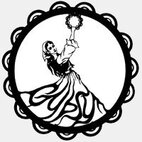 GYPSY logo | The Beginnings: Gypsy is one of Southern California's oldest dance groups, tracing its origins back over forty years to 1978. The company was formed that year as a performance group focused mainly on Romanian and Greek dance. Some of this material was provided by the brothers Mihai and Alexandru David as a legacy from their former performing troup "Bessarabia" - several members of Gypsy had previously danced with "Bessarabia." The new ensemble performed extensively throughout 1978 and 1979, including appearances at the Los Angeles Street Scene festival in both of those years. The GYPSY logo, a Gypsy woman inside the circle of a tambourine with the folds of her skirt spelling out the word "GYPSY", also dates from this time. | |
Performing Tree and ICAP: The company was reorganized in 1981, and with help from the Greek dancer and teacher Athan Karras, the group's emphasis was changed from being purely performance oriented to a focus on presenting dance programs and workshops for Los Angeles area schools. In early 1982, Gypsy joined Performing Tree, a non-profit organization dedicated to arts in education which provided arts programs for schools throughout Los Angeles County. School presentations began in March 1982. Gypsy continued performing in the community with a repertoire which included Romanian and Greek dance along with Armenian, Russian, Hungarian and Arabic material. At this time, Gypsy also initiated its long partnership with St Luke Orthodox Church in Garden Grove, California. | 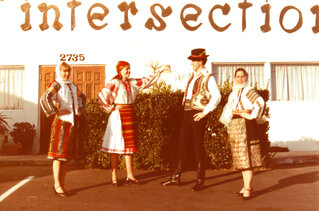 Posing outside Athan Karras' folk dance coffee house "Intersection", an early Gypsy rehearsal site and performance venue | |
Beginning with the Fall 1982 Semester in Los Angeles schools, Gypsy also began presenting school programs through the Intergroup Cultural Awareness Program (ICAP), part of the Los Angeles Unified School District (LAUSD), starting an affiliation with the District that continues to this day. In the following years, Gypsy kept a busy schedule with assembly programs, workshops and teaching residencies for Performing Tree and ICAP. Los Angeles Olympic Games 1984: The Olympic Games returned to Los Angeles in 1984 after fifty years. Gypsy was very pleased to be chosen by the Los Angeles Olympic Organizing Committee to perform at several venues for the ceremonies. Below are some photo memories of the events showing Greek, Romanian and Balkan suites: | ||
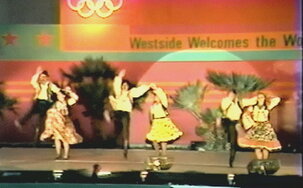 | 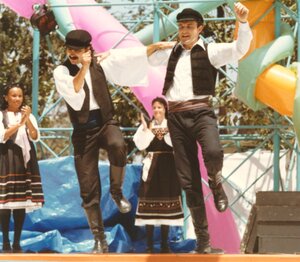 | 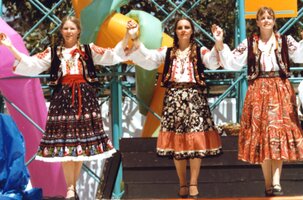 |
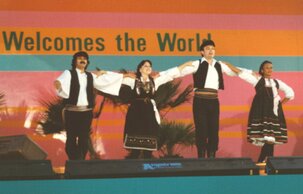 | 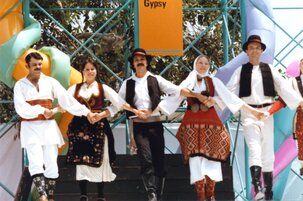 1984 Los Angeles Olympic Games | 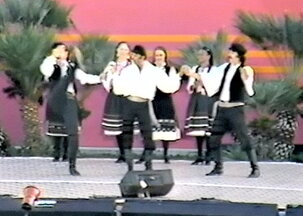 |
Adding to the repertoire:
In these early years, Gypsy's repertoire was heavily weighted with choreographies from Eastern Europe and the Balkans, with some additional dances from the Middle East. This is, of course, the area most influenced by Gypsy music and dance, hence the name of the company. This was also familiar material for many members of the company who were also recreational folk dancers. But requests from clients and a wish to expand our offerings led to the addition of dances from other cultures and geographical areas.
- German dance
Starting in 1985, Gypsy began annual performances at the Oktoberfest celebrations at Old World Village in Huntington Beach, California. In the first few years Gypsy stayed with its standard material of Greek and Romanian dances, but began to add German dances as well and by 1989 was performing a full suite of German Oktoberfest dances. Gypsy continued appearing at Old World Village for several more years and the Oktoberfest suite has proven to be one of our most popular offerings and has become one of the mainstays of our dance repertory.
- Italian dance
Gypsy has had a long history of interaction with Italian community in Southern California and one or two Italian dances have long been part of the company's repertoire. This small start was added to from 1990 on and by the Spring of 1992, we were able to mount a full concert of Italian folk dance for College of the Canyons in Santa Clarita, California.
- Polynesian dance
In the early years of the company, one of the most frequent requests from clients was to add Polynesian dances. This was unfamiliar territory to most of the group's dancers and it wasn't until 1992 that the ensemble recruited the expertise of local Polynesian dance teachers Mary Ann Rogiers and Maile Peters for training and choreographies. Very soon, Lu'au season (July and August) became the busiest time of the year for the dancers and Polynesian dance presentations today make up a substantial part of Gypsy's performances.
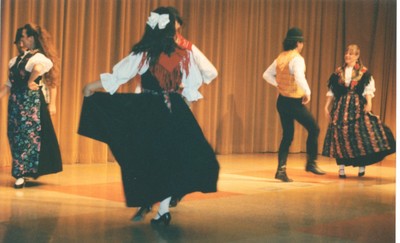 Italian dance at College of the Canyons | 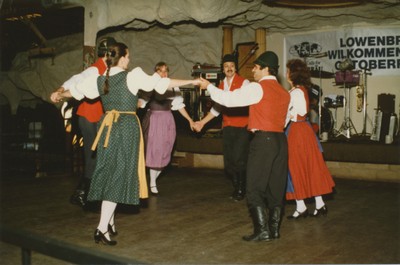 German dance at Old World Village | |
Reaching out to a new audience:
By 1990 Gypsy's personnel had grown since the early days and the group began to search for new venues to present shows. It was decided to start an outreach program for seniors in retirement and convalescent homes. A small start was made in September 1990 at senior facilities in Los Angeles and Culver City using the newly developed Oktoberfest suite of dances. In the next few years further suites were added including Irish, Italian, Greek and Polynesian. In the shows, two or four dancers present a 45 minute program of dance and narration, with sometimes a few songs and stories, and with audience participation.
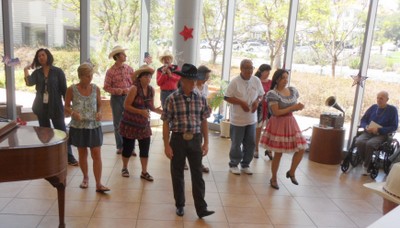 Teaching an American folk dance to seniors | 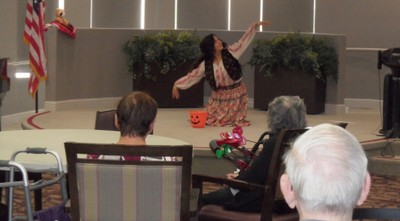 Halloween dance with pumpkin | |